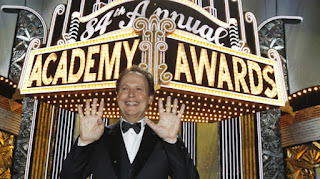Oscars Give Short Shrift to Foreign, Documentary Categories
By Steven Rosen
from www.citybeat.com, 2-29-12

Now that Sunday night’s Oscars are over, the Internet is full of catty stories and tweets parsing every last second of televised coverage, from Angelina Jolie’s exposed leg to Adam Sandler’s participation in a taped segment in which actors discussed why they love movies. (If he really loved movies, he’d stop making them, some have said.)
It’s both understandable and sad that the Oscars — and movie-award season in general — ends like this, with far more interest in the telecast’s trivia than in the movies that win awards. Arguably, the news value of this year’s show peaked before it even officially started, when Sacha Baron Cohen, in costume as “The Dictator” for an upcoming movie, spilled an urn of faux human ashes (ostensibly Kim Jong-il’s) on interviewer Ryan Seacrest.
It’s getting worse, too, now that the Internet and 200+-channel cable television have educated us ad nauseam to the nature and inner workings of the Oscar campaign season. We carefully learn how a film builds momentum by moving through all the secondary award ceremonies from critics groups and the Hollywood professional guilds and associations.
As a result, the Academy Awards themselves have become anticlimactic, which partially explains the media devotion to dissecting the telecast. And the attempts by the Motion Picture Academy to build false enthusiasm by allowing up to ten Best Picture nominees have been a disaster, since we all now know how to “read” the nominations to distinguish the real ones (they also have Best Director nods) from the padding. Not all that long ago, few outside Hollywood insiders even knew there was a well-orchestrated “campaign season,” much less how to follow and handicap it.
Convention wisdom, and you hear a lot of it these days, would be to revive the Oscar telecast by de-emphasizing the importance of the awards, themselves. Reduce the number given out on TV, especially the more esoteric or niche ones, in favor of increasing the glitz, spectacle, star power and big production numbers. Do like the Grammys have done, where classical, jazz, folk, blues, opera, international and more are rarely ever presented on the show.
But I think the Academy should go the other way and try to increase public awareness of the importance of Oscar nominations. But maybe not for the Big Four categories – Best Picture, Director, Actor and Actress, which probably do suffer from overexposure by the time the telecast comes around (although The Artist, this year’s big winner, could use the help since many people have been scared off by the fact it’s a black-and-white silent film).
Click the jump for more on ways the Academy could draw more attention to deserving films such as A Separation, In Darkness, Footnote and Bullhead.
In particular, there should be more attention given to two categories that get a short shrift on the telecast, yet for which Oscar nominations are vital – Best Foreign Language Film and Best Documentary. It would even be a good idea for the Academy to launch a second telecast, on cable, devoted just to introducing these nominees to the public.
(The awards could still be given on the main program, and Foreign and Documentary films could still be eligible for the major awards, too.)
Why? First of all, foreign-language films and documentaries are feature-length movies, just like The Artist (which actually was a French movie) or The Descendents. As such, they’re trying to get into theaters and be seen, just like those films. Further, as anyone who really likes movies can tell you, they are often the best feature-length movies out there because they explore subjects that Hollywood overlooks and take risks that scare Hollywood.
Yet, because they rarely if ever have the studio marketing/distribution clout to get into wide national release, they struggle in the marketplace. They even struggle to attract the attention of those who are predisposed to like artier or so-called independent films. Occasionally, a political celebrity like Michael Moore or Al Gore can break through with a documentary, or a foreign-language film like Ang Lee’s Crouching Tiger, Hidden Dragon can combine enough action with artfulness to become a hit. But too often, they don't get the attention they deserve. one of this year's foreign-language nominees, Belgium's tough, harrowing Bullhead, quietly opened at the Esquire last week and I wonder how many people know that much about it. Several of this year’s Best Documentary nominees — Hell and Back Again, If a Tree Fell, Paradise Lost 3 — tell riveting stories about the contemporary American experience but didn’t even get widespread theatrical distribution. The winner, Daniel Lindsay and T.J. Martin’s Undefeated, about a struggling Memphis high-school football team, will get a push because it won the Oscar. (The other nominee, Wim Wender’s 3-D look at an avant-garde German dance troupe, Pina, is currently at the Mariemont.)
Distributors often don’t try to really market a documentary or foreign-language film until after the Oscars are over – that’s how dependent they are on an award. So it’d be nice if a second, special Academy’s Oscar telecast gave them more time to introduce and explain themselves.
It could introduce the nominees in depth, show clips from them, offer interviews with the principals and – in the case of the foreign-language nominees – offer insight into the filmmaking industry in their home countries. As for star power, I would bet Hollywood’s top stars and directors would be willing to introduce the segments – heck, Terrence Malick and Woody Allen probably would show up for such a good cause.
Among other things, a show could explain the confusing process by which documentaries and foreign-language films become eligible for Oscar nominations. Maybe the more the public learns about that, the more it will suggest changes. (Why should only foreign-language films officially nominated by their countries be eligible, for instance?)
This is also important because these categories are exciting. The foreign-language one, in particular, is like a mini-United Nations. For those who follow these movies, one of the most meaningful moments at the Oscars occurred when A Separation, written and directed by Iranian director Asghar Farhadi, won for Best Foreign Language Film. It’s the first Iranian film to win in this category and opens Friday at the Esquire.
Framed as a thriller, this very contemporary movie about a marriage in trouble daringly, carefully asks questions about the role of women in a male-dominated, religious-dominated society. And Farhadi’s acceptance speech, while hard to understand since English isn’t his primary language, seemed to be a call for understanding, peace and cultural tolerance, as well as to ask that we all separate politics from the social/cultural realm. It seemed to be directed at Iranian authorities as much as anyone else, and the New York Times said the Iranian news agencies had trouble reporting it in a way that would curry its government’s favor. And indeed, the Iranian government has spun the win as a victory over Israel.
That’s because one of the other finalists, Joseph Cedar’s Footnote, also a family drama, is an Israeli film. The Academy on Saturday sponsored an annual symposium for its foreign-film nominees, and it was something that Farhadi would dare appear at the event with Cedar. (He still had to be careful about seeming to be too friendly to him.) Further, one Jewish website (www.jta.org) reported that Farhadi backstage at the Oscars praised the director of another foreign-language nominee — Agnieszka Holland’s Polish drama In Darkness, about Jews hiding from Nazis in Lvov, Poland, during the Holocaust. If true that’s pretty gutsy for him, considering Iran’s political leadership denies the Holocaust happened.
This is exciting, relevant stuff — certainly more substantial than whatever a costumed Cohen does to Ryan Seacrest on the red carpet. But why can’t the Academy do more to let the television-watching public in on the stories behind these films. And if that helps A Separation, In Darkness, Footnote, Bullhead or the fifth nominee, Canada’s Monsieur Lazhar (about an Algerian refugee in Montreal) attract a bigger audience as they start to “go wide” theatrically, we’re all better for it.
And, who knows, if it works for the Oscars, maybe the Grammys can follow suit and have a separate telecast for some of the musical categories it’s now abandoned on its main show.
To read more work by Steven Rosen, visit www.stevenrosenwriter.com.










